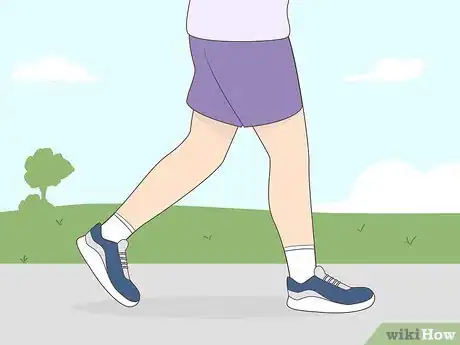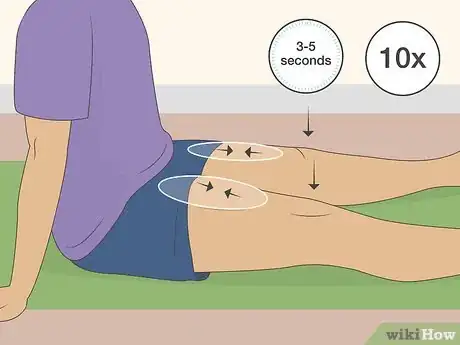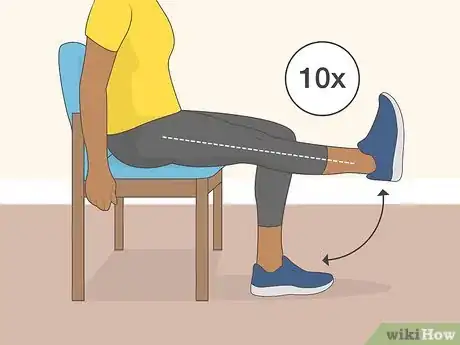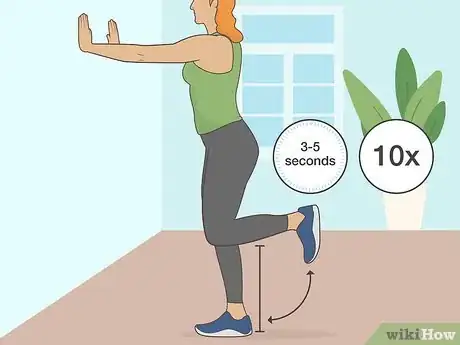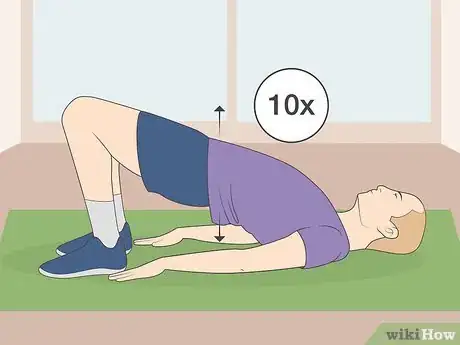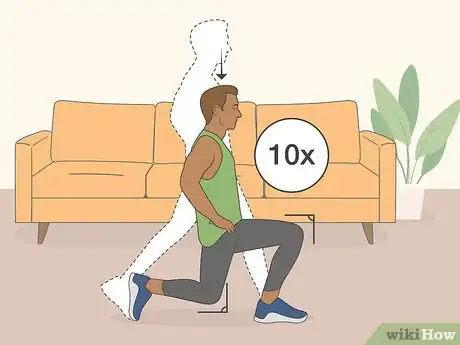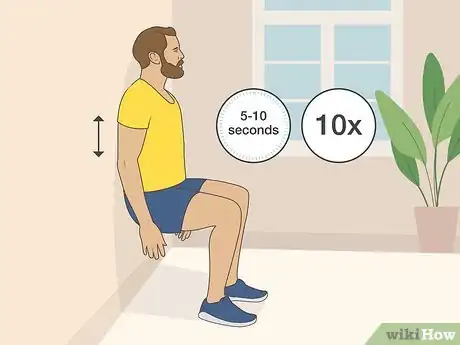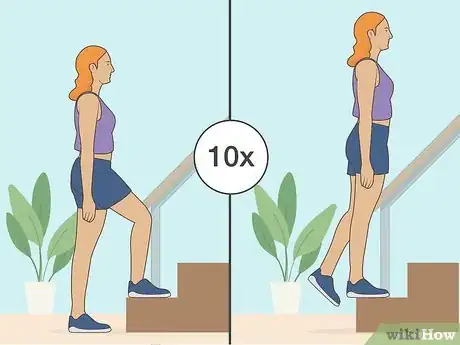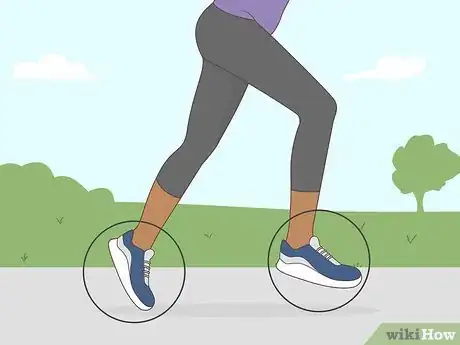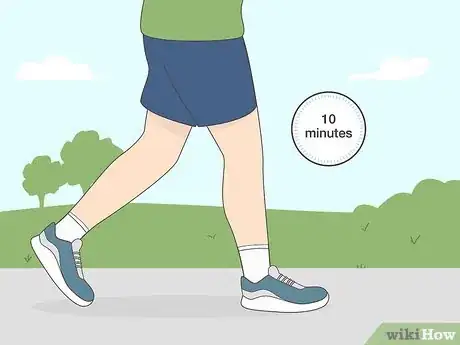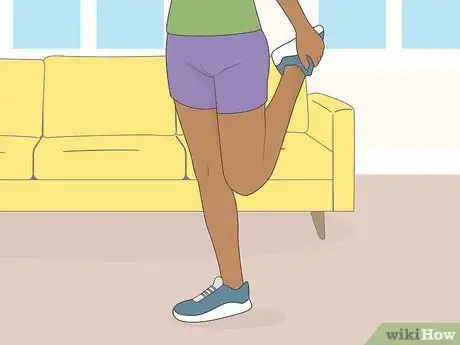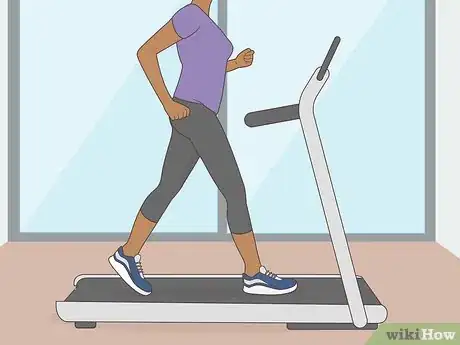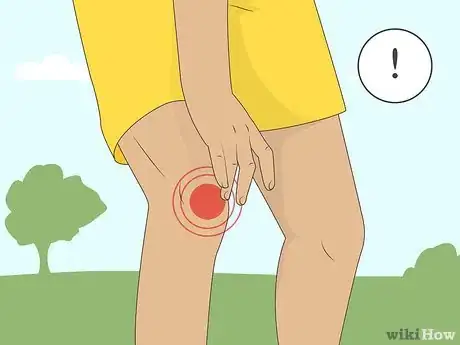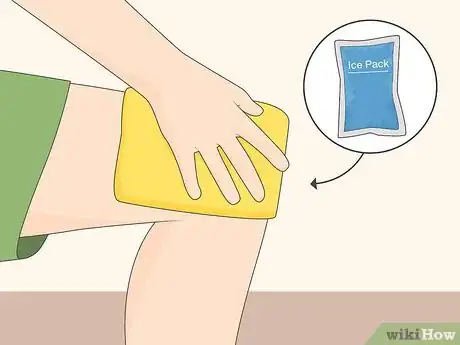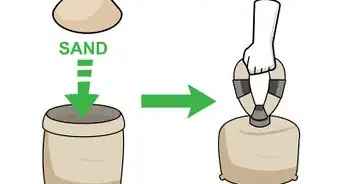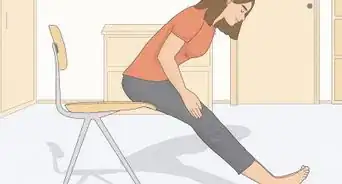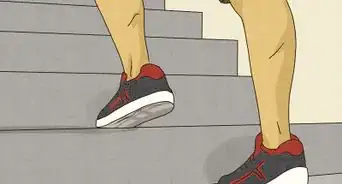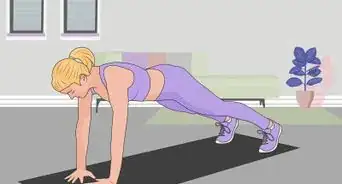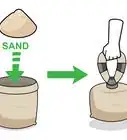This article was co-authored by Steve Horney PT, MPT, MTC, CSCS. Steve Horney is a Licensed Physical Therapist and the Owner of Integrated Health Sciences, a New York City-based company that provides continuing education, health care products, and manual and movement physical therapy. Steve has over 15 years of academic and professional physical therapy training and specializes in the assessment and treatment of athletes with the goal of helping them become pain-free and less susceptible to injury. Steve is also a certified strength and conditioning specialist (CSCS) from the National Strength and Conditioning Association (NSCA). He received a BS in Health Science from Quinnipiac University in 2004 and a Masters of Physical Therapy (MPT) from Quinnipiac University in 2006. He then completed his Manual Therapy Certification (MTC) from the University of St. Augustine in 2014.
There are 7 references cited in this article, which can be found at the bottom of the page.
This article has been viewed 14,936 times.
Knee pain can be a real inconvenience in your daily life. It could be from arthritis, tendonitis, injuries, or just plain muscle tightness. The good news is that it doesn’t have to stop you from staying in shape. In fact, regular exercise is a great way to treat and relieve knee pain, no matter what the cause is.[1] Even better, most of these exercises aren't difficult at all. With the right moves, you can get started on improving your knee pain today!
Steps
Knee-Strengthening Exercises
-
1Walking: This might not be what you were thinking of, but normal walking is great exercise. It’s also great for strengthening your knees and relieving pain, whether you have arthritis, structural problems, or an injury. Try taking a daily walk to stay in shape and keep your joints strong.[2]
- It’s still possible to overdo it with walking, even though it’s a low-impact exercise. Stay close to home when you’re getting started and head back if your knees bother you.
- You could also walk on a treadmill or just pace around your home. This all counts.
-
2Quad contractions: Sit on a flat, solid surface, like your floor, and stretch your legs in front of you. Then squeeze both of your quads, or thigh muscles, like you’re trying to press your knee down into the floor. Hold that for 3-5 seconds, then release. Repeat 3 sets of 10 reps for a full workout.[3]
- This also works as a good stretching activity, so you can do it as part of your exercise routine or as a warm-up.
Advertisement -
3Straight leg raise: Start by sitting in a chair with both feet on the ground. Bend your knee up to straighten one of your legs as much as you can. Then bend your knee back down slowly to lower your leg back to the floor. Repeat this 10 times before switching sides.[4]
- For a full workout, do 2-3 sets of this exercise.
- This exercise will strengthen your gluteus maximus, which will improve your overall knee health.[5]
- There is also a variation of this exercise where you lay on the floor instead of sitting in a chair. Lay on your back with both legs bent and your feet a few inches from your hips. Then lift one leg at the knee to complete a set before switching legs.[6]
- When you get stronger, you can combine leg raises and quad contractions. Raise your leg and when you reach the top of your motion, squeeze your quad and hold it for a few seconds.
-
4Hamstring curls: Stand with your feet together in front of a chair or wall and put your hands on it for balance. Shift your weight to one leg for support, then bend your knee on the other leg to bring your foot up towards your buttocks. Lift until your shin is parallel with the ground and hold it for 3-5 seconds. Lower it slowly and repeat the exercise 10 times before switching legs. For a full workout, do 2-3 sets.[7]
- Keep your knees close together for this exercise. The point isn't to pull them apart.
-
5Bridges: This exercise is a common yoga pose, and it’s great for strengthening your hips and thigh muscles to take pressure off your knees. Lay on your back with your knees bent and your feet a few inches from your hips. Plant your feet and slowly raise your hips off the floor as high as you can. Hold at the top for a few seconds, then slowly lower yourself back down. Repeat this 10 times for a set and do 2-3 sets for a full workout.[8]
- Don’t use your arms to lift yourself. Make sure all the motion comes from your hips.
- When you feel stronger, you can wrap an exercise band around your knees while you’re doing bridges. You’ll have to focus on preventing the band from pulling your legs together, which strengthens your leg muscles and tendons.
- You’ll be more comfortable if you do this exercise on a yoga mat or carpet.
-
6Lunges: Stand with your feet shoulder-width apart. Then take a big step forward while keeping your knees straight, so you’re standing in a half-split and facing forward. Put your hands on your hips or stretch them out to the sides for balance. Slowly bend your knees to lower yourself into a lunge. Try to make a right angle with your legs before slowly raising yourself back up. Repeat this 10 times before switching sides, and do 2-3 sets for a full workout.[9]
- When you’re feeling stronger, you can do this exercise with weights in your hands.
- There are lots of lunge variations, so don’t be afraid to mix some of these into your workout.
-
7Wall squats: Stand with your back flat against a wall for support and your feet shoulder-width apart. Step your feet about 2 ft (0.61 m) from the wall. Then bend your knees to lower your body, while staying pressed against the wall. When you’ve gone as low as you can, hold that for 5-10 seconds, then slowly raise yourself back up. Repeat this 10 times for a set.[10]
- If you’re feeling strong enough, you can do squats without leaning on the wall.
- You can also hold weights in your hands for more of a workout.
-
8Single leg dips: Stand between 2 chairs with their backs facing you. Place your hands on the chairs for balance, and lift one leg out in front of you. Bend your knee on your planted foot to lower yourself 3–5 in (7.6–12.7 cm) and hold that for 3-5 seconds. Repeat 10 times and then switch legs.[11]
- Only use the chairs for balance and don't lean on them too hard. Otherwise they might tip.
- You could also do this without chairs if you have good balance.[12]
-
9Step ups: Stand in front of a staircase or stepstool. Step one foot onto the ledge and lift your back foot off the ground. Let that foot hang off the back of the ledge, keep all the weight on your front foot. Lower your back foot to the floor, then repeat this motion 10 times before switching sides.[13]
- Make sure the platform you’re stepping onto is stable. If it wobbles or falls, you could get hurt.
Safety Tips
-
1Wear supportive shoes whenever you’re exercising. If you have knee pain, then you definitely need extra support. Get good-quality running shoes with plenty of cushioning. Make sure they fit you properly and aren’t too tight. This should keep your knees supported during your workouts.[14]
- Old running shoes lose their cushioning and could cause joint pain. If your shoes are worn-out and your knees are hurting, it’s probably time for a new pair.
-
2Warm up with light activities. If you start working out before your muscles are ready, it could definitely cause knee pain. Always do some light walking or cycling for about 10 minutes before you exercise. This loosens your muscles up and gets them ready for exercise.[15]
- You could also do other cardio activities like jumping jacks or jumping rope as a warmup. Any activity will work as long as it gets your heart rate up and makes you break a light sweat.
-
3Do knee stretches along with your exercises. Knee pain could be from overuse or tight muscles. In this case, some stretches could help. Do these stretches before and after exercising to keep your leg muscles nice and loose.[16]
- Quad stretch: Stand with your feet shoulder-width apart. Bend one of your knees to bring you foot up towards your buttocks. Grab your foot with your hand and press it against your glute. Hold the stretch for 30 seconds, then lower it slowly and switch legs.
- Hamstring stretch: Sit on the floor with your feet straight in front of you. Lean down as far as you can and try to touch your toes. Keep your back straight and don't round it. Hold this position for 30 seconds.
-
4Stick with low-impact cardio and aerobic exercises. Low-impact activities don’t put pressure on your joints, so they’re best for your knees. Some good ones include walking, swimming, cycling, and aerobics classes. Get your cardio from these activities to protect your knees.[17]
- A stationary bike or treadmill are great low-impact activities if you want to stay home.
- You can still do some light running if you have knee pain, as long as it doesn’t make the pain worse.
-
5Stop if you feel pain in your knees. Exercise shouldn't cause a lot of joint pain. If the pain is getting worse while you’re exercising, then you’re probably pushing your knees too hard. Stop right away before you do any more damage.[18]
- Try stopping and stretching for a few minutes if your knees start hurting. Start the exercise again slowly. If the pain comes back, then skip this exercise for today.
-
6Ice your knees when you’re finished exercising. Any exercise could cause some inflammation in your knees. When you’re all done working out, wrap an ice pack in a towel and hold it on your knees for 15-20 minutes. This can get rid of any inflammation in your joints.
- You can also ice your knees 3-4 throughout the day, whether or not you exercised. This helps get rid of any residual inflammation that might be causing pain.
- Don’t use an ice pack without wrapping it in a towel first. This could cause frostbite.
Expert Q&A
Did you know you can get expert answers for this article?
Unlock expert answers by supporting wikiHow
-
QuestionCan exercise relieve pain?
 David Schechter, MDDr. David Schechter is a physician in Culver City, California. With over 25 years of experience as a family and sports medicine physician, Dr. Schechter specializes in mind-body medicine, preventive medicine, and chronic pain. Dr. Schechter received his MD from New York University and is an attending physician at Cedars-Sinai Medical Center. He was named a Top Doctor by Los Angeles Magazine and Men's Health Magazine. He has also written several books, including The MindBody Workbook.
David Schechter, MDDr. David Schechter is a physician in Culver City, California. With over 25 years of experience as a family and sports medicine physician, Dr. Schechter specializes in mind-body medicine, preventive medicine, and chronic pain. Dr. Schechter received his MD from New York University and is an attending physician at Cedars-Sinai Medical Center. He was named a Top Doctor by Los Angeles Magazine and Men's Health Magazine. He has also written several books, including The MindBody Workbook.
Family Medicine Practitioner Absolutely, but it has to be the right type of exercise for your specific type of pain. For example, if you have back pain around the middle of your back, rowing exercises are great for relieving the pain. Stretching can alleviate pain from muscle spasms. At the same time, you wouldn't want to go running if you have foot pain. It really depends on the exercise and the pain.
Absolutely, but it has to be the right type of exercise for your specific type of pain. For example, if you have back pain around the middle of your back, rowing exercises are great for relieving the pain. Stretching can alleviate pain from muscle spasms. At the same time, you wouldn't want to go running if you have foot pain. It really depends on the exercise and the pain. -
QuestionHow can I strengthen my knees?
 Steve Horney PT, MPT, MTC, CSCSSteve Horney is a Licensed Physical Therapist and the Owner of Integrated Health Sciences, a New York City-based company that provides continuing education, health care products, and manual and movement physical therapy. Steve has over 15 years of academic and professional physical therapy training and specializes in the assessment and treatment of athletes with the goal of helping them become pain-free and less susceptible to injury. Steve is also a certified strength and conditioning specialist (CSCS) from the National Strength and Conditioning Association (NSCA). He received a BS in Health Science from Quinnipiac University in 2004 and a Masters of Physical Therapy (MPT) from Quinnipiac University in 2006. He then completed his Manual Therapy Certification (MTC) from the University of St. Augustine in 2014.
Steve Horney PT, MPT, MTC, CSCSSteve Horney is a Licensed Physical Therapist and the Owner of Integrated Health Sciences, a New York City-based company that provides continuing education, health care products, and manual and movement physical therapy. Steve has over 15 years of academic and professional physical therapy training and specializes in the assessment and treatment of athletes with the goal of helping them become pain-free and less susceptible to injury. Steve is also a certified strength and conditioning specialist (CSCS) from the National Strength and Conditioning Association (NSCA). He received a BS in Health Science from Quinnipiac University in 2004 and a Masters of Physical Therapy (MPT) from Quinnipiac University in 2006. He then completed his Manual Therapy Certification (MTC) from the University of St. Augustine in 2014.
Licensed Physical Therapist
Warnings
- If you have consistent knee pain, it’s best to see your doctor. You might have arthritis or a similar condition that needs treatment.⧼thumbs_response⧽
References
- ↑ https://www.rush.edu/news/preventing-knee-pain
- ↑ https://www.rush.edu/news/preventing-knee-pain
- ↑ https://youtu.be/ikt6NME0k9E?t=167
- ↑ https://www.nhs.uk/live-well/exercise/knee-exercises-for-runners/
- ↑ Steve Horney PT, MPT, MTC, CSCS. Licensed Physical Therapist. Expert Interview. 27 March 2020.
- ↑ https://orthoinfo.aaos.org/en/staying-healthy/knee-exercises/
- ↑ https://orthoinfo.aaos.org/en/staying-healthy/knee-exercises/
- ↑ https://youtu.be/pOrc3zADC7k?t=160
- ↑ https://www.nhs.uk/live-well/exercise/knee-exercises-for-runners/
- ↑ https://orthoinfo.aaos.org/en/staying-healthy/knee-exercises/
- ↑ https://orthoinfo.aaos.org/en/staying-healthy/knee-exercises/
- ↑ https://www.nhs.uk/live-well/exercise/knee-exercises-for-runners/
- ↑ https://www.rush.edu/news/preventing-knee-pain
- ↑ https://www.rush.edu/news/preventing-knee-pain
- ↑ https://orthoinfo.aaos.org/en/staying-healthy/knee-exercises/
- ↑ https://orthoinfo.aaos.org/en/staying-healthy/knee-exercises/
- ↑ https://www.mayoclinic.org/diseases-conditions/arthritis/in-depth/arthritis/art-20047971
- ↑ https://orthoinfo.aaos.org/en/staying-healthy/knee-exercises/
- ↑ https://www.rush.edu/news/preventing-knee-pain
